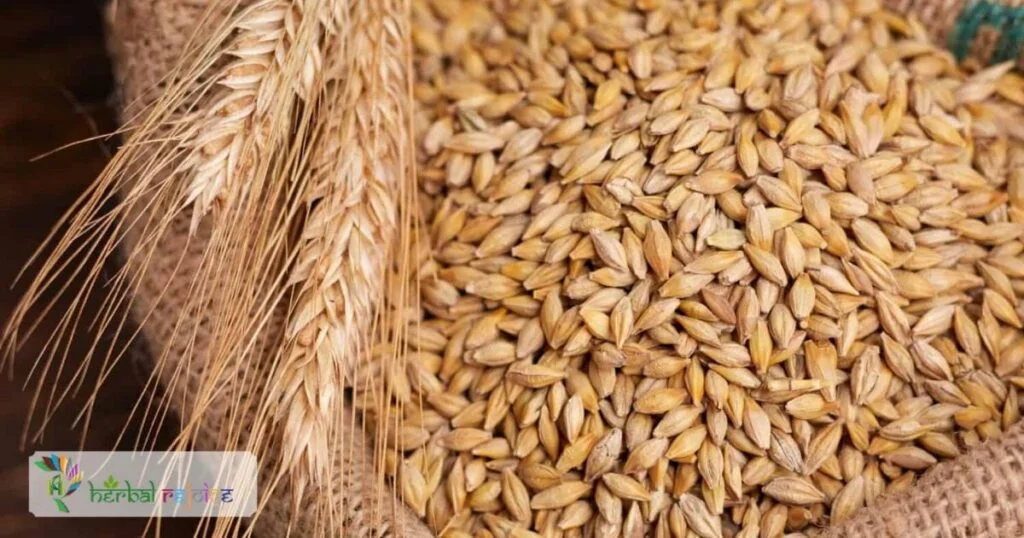Intoduction
Barley (Hordeum vulgare Linn.) is a cereal crop that is cultivated as a food crop in various states of India. Barley is nutritive and demulcent food during the recovery period in cases of bowel inflammation and diarrhea. It is used to treat obesity and urinary disorders.
Names and Habitat
It is commonly found in Uttar Pradesh, West Bengal, Bihar, Madhya Pradesh, Rajasthan, Haryana, Punjab, Himachal Pradesh, and Jammu and Kashmir.
In Ayurveda, barley is known as Yava, Hayeshtha, Hayapriya, Shuka-dhaanya, and Tikshnashuka.
In Unani medicine, it is referred to as Barley or Jao Shaeer. In Siddha medicine, it is called Yavam and Saambaluppu (ash).
Traditinal Health Benefits Of Barley
Barley has various actions and benefits according to different systems of medicine. In Ayurveda, it is considered to be a nutritive and demulcent food during the recovery period after an illness, as well as in cases of bowel inflammation and diarrhea. It also helps in protecting the immune system.
The Ayurvedic Pharmacopoeia of India recommends the use of barley in urinary disorders, muscular rigidity, chronic sinusitis, cough, asthma, lipid disorders, and obesity.
Chemical Constituents Of Barley
The juice of young barley leaves is particularly beneficial as it is seven times richer in vitamin C than oranges, five times richer in iron than spinach, and 25 times richer in potassium than wheat. It is also high in SOD (superoxide dismutase), an enzyme that slows down the aging of cells.
The nutritional quality of barley depends on the beta-glucan fraction present in the grain. Beta-glucan-enriched fractions have been found to have cholesterol-lowering effects in hamsters.

Key Components Of Barley
Naked barley extracts have shown potential in inhibiting cyclohexanase activity, which makes them useful in treating thrombosis and atherosclerosis.
The ethanol extract of young green barley leaves exhibits antioxidant, anti-inflammatory, and antiallergic activities, attributed to a flavonoid called 2-O-glucosylisovitexin. Moreover, the leaves of barley contain an indole alkaloid called gramine, which exhibits antibacterial properties.
Dosage
When using barley for its therapeutic benefits, dried fruit can be consumed in a dosage of 100-200 grams, according to the Ayurvedic Pharmacopoeia of India. Dried plant parts can be consumed in a dosage of 10-20 grams.
Conclusion
In conclusion, barley (Hordeum vulgare Linn.) is an important food crop cultivated in several states of India. It has been used in various traditional medicinal systems for its nutritive, demulcent, and protective properties.
Barley is recommended for various health conditions, including urinary disorders, muscular rigidity, chronic sinusitis, cough, asthma, lipid disorders, and obesity.
The juice of young barley leaves is particularly beneficial due to its high content of essential nutrients. Moreover, barley extracts have shown potential in reducing cholesterol levels, inhibiting thrombosis and atherosclerosis, and exhibiting antioxidant, anti-inflammatory, and antibacterial activities.
When using barley for therapeutic purposes, it is important to follow the recommended dosages mentioned in the Ayurvedic Pharmacopoeia of India.
Frequently Asked Questions(FAQs)
Where is barley cultivated in India?
Barley is cultivated in various states of India, including Uttar Pradesh, West Bengal, Bihar, Madhya Pradesh, Rajasthan, Haryana, Punjab, Himachal Pradesh, and Jammu and Kashmir.
What is barley known as in Ayurveda?
In Ayurveda, barley is known as Yava, Hayeshtha, Hayapriya, Shuka-dhaanya, and Tikshnashuka.
What is barley called in Unani medicine?
In Unani medicine, barley is referred to as Barley or Jao Shaeer.
How is barley referred to in Siddha medicine?
In Siddha medicine, barley is called Yavam and Saambaluppu (ash).
What are the benefits of barley according to Ayurveda?
According to Ayurveda, barley is considered to be a nutritive and demulcent food during the recovery period after an illness. It is also beneficial in cases of bowel inflammation and diarrhea. Additionally, it helps in protecting the immune system.
What health conditions is barley recommended for in Ayurveda?
Barley is recommended for urinary disorders, muscular rigidity, chronic sinusitis, cough, asthma, lipid disorders, and obesity according to the Ayurvedic Pharmacopoeia of India.
What are the nutritional benefits of young barley leaves?
The juice of young barley leaves is seven times richer in vitamin C than oranges, five times richer in iron than spinach, and 25 times richer in potassium than wheat. It is also high in SOD (superoxide dismutase), an enzyme that slows down the aging of cells.
What is the beneficial component of barley for cholesterol reduction?
The beta-glucan fraction present in barley has been found to have cholesterol-lowering effects in hamsters.
What potential benefits do naked barley extracts have?
Naked barley extracts have shown potential in inhibiting cyclohexanase activity, making them useful in treating thrombosis and atherosclerosis.
What are the medicinal properties of the ethanol extract of young green barley leaves?
The ethanol extract of young green barley leaves exhibits antioxidant, anti-inflammatory, and antiallergic activities, attributed to a flavonoid called 2-O-glucosylisovitexin.
What antibacterial properties does barley possess?
The leaves of barley contain an indole alkaloid called gramine, which exhibits antibacterial properties.
What is the recommended dosage of dried barley fruit?
According to the Ayurvedic Pharmacopoeia of India, dried barley fruit can be consumed in a dosage of 100-200 grams.
What is the recommended dosage of dried barley plant parts?
Dried barley plant parts can be consumed in a dosage of 10-20 grams.
Is barley a staple crop in India?
Yes, barley is an important food crop cultivated in several states of India.
What are the specific therapeutic properties of barley?
Barley is known for its nutritive, demulcent, and protective properties.
Can barley be beneficial in treating bowel inflammation?
Yes, barley is considered beneficial in cases of bowel inflammation, according to Ayurveda.
Is barley recommended for immune system support?
Yes, barley is known to help protect the immune system.
Is the juice of young barley leaves more nutritious than oranges?
Yes, the juice of young barley leaves is seven times richer in vitamin C than oranges.
Does barley have cholesterol-lowering effects?
Yes, the beta-glucan fraction present in barley has been found to have cholesterol-lowering effects in hamsters.


